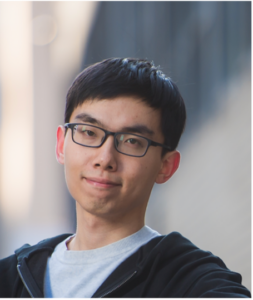 Grace Noel’s work focuses on a thermally drawn “acoustic fiber” containing a piezoelectric domain that can be incorporated into textiles to create fabric microphones. With the piezoelectric domain of the acoustic fiber sensing vibrations from the wearer, it can continuously and imperceptibly capture acoustic signals, functioning like a wearable stethoscope. In the thermal drawing process, multiple viscoelastic materials flow in a laminar regime, maintaining the cross-sectional geometry of the macroscopic preform. The acoustic fiber contains a piezoelectric composite domain, conductive polymer electrodes, and an elastomeric cladding, which co-flow at the elevated draw temperature and result in a multimaterial fiber device. Acoustic fibers detect heartbeat and breathing with high reliability, and arrays of fibers capture acoustic signals with high enough resolution to determine the direction of the sound source with 1-degree accuracy. Given the success of the fiber in detecting adult heartbeat, Grace is now exploring using the acoustic fabric for fetal monitoring. Monitoring fetus activity can provide data for robust identification of at-risk pregnancies to provide proactive care and decrease fetal mortality. Given the acoustic fiber’s unprecedented piezoelectric coefficient and its unique form factor, she believes that this is only the beginning of using the fiber in biomedical applications. Grace is a Ph.D. student in the Department of Chemical Engineering, and she conducts research under the supervision of Prof. Yoel Fink.
Grace Noel’s work focuses on a thermally drawn “acoustic fiber” containing a piezoelectric domain that can be incorporated into textiles to create fabric microphones. With the piezoelectric domain of the acoustic fiber sensing vibrations from the wearer, it can continuously and imperceptibly capture acoustic signals, functioning like a wearable stethoscope. In the thermal drawing process, multiple viscoelastic materials flow in a laminar regime, maintaining the cross-sectional geometry of the macroscopic preform. The acoustic fiber contains a piezoelectric composite domain, conductive polymer electrodes, and an elastomeric cladding, which co-flow at the elevated draw temperature and result in a multimaterial fiber device. Acoustic fibers detect heartbeat and breathing with high reliability, and arrays of fibers capture acoustic signals with high enough resolution to determine the direction of the sound source with 1-degree accuracy. Given the success of the fiber in detecting adult heartbeat, Grace is now exploring using the acoustic fabric for fetal monitoring. Monitoring fetus activity can provide data for robust identification of at-risk pregnancies to provide proactive care and decrease fetal mortality. Given the acoustic fiber’s unprecedented piezoelectric coefficient and its unique form factor, she believes that this is only the beginning of using the fiber in biomedical applications. Grace is a Ph.D. student in the Department of Chemical Engineering, and she conducts research under the supervision of Prof. Yoel Fink.
 Changhao Li conducted his PhD studies in the Quantum Engineering Group under the supervision of Prof. Paola Cappellaro at MIT. Mr. Li’s research focuses on quantum information science, including quantum sensing and computation. Particularly, his research projects include the utilization of spin defects, specifically nitrogen-vacancy (NV) centers inside nanodiamonds, as quantum sensors to investigate external biological and chemical stimuli. In his recent research undertaking, Li and colleagues engineer a hybrid quantum sensor based on NV centers, devised to discern the presence and quantify the amount of the SARS-CoV-2 virus. The presence of virus RNA will trigger a change of local magnetic field, which the NV center exhibits high sensitivity towards. The designed sensor is predicted to have low false negative rate and excellent quantum sensitivity, and its applicability extends to the detection of other viruses. Li has also been working on using NV centers in nanodiamonds to detect fast rotational Brownian motion of nanoscale molecules and probe alkali ions in solution.
Changhao Li conducted his PhD studies in the Quantum Engineering Group under the supervision of Prof. Paola Cappellaro at MIT. Mr. Li’s research focuses on quantum information science, including quantum sensing and computation. Particularly, his research projects include the utilization of spin defects, specifically nitrogen-vacancy (NV) centers inside nanodiamonds, as quantum sensors to investigate external biological and chemical stimuli. In his recent research undertaking, Li and colleagues engineer a hybrid quantum sensor based on NV centers, devised to discern the presence and quantify the amount of the SARS-CoV-2 virus. The presence of virus RNA will trigger a change of local magnetic field, which the NV center exhibits high sensitivity towards. The designed sensor is predicted to have low false negative rate and excellent quantum sensitivity, and its applicability extends to the detection of other viruses. Li has also been working on using NV centers in nanodiamonds to detect fast rotational Brownian motion of nanoscale molecules and probe alkali ions in solution.